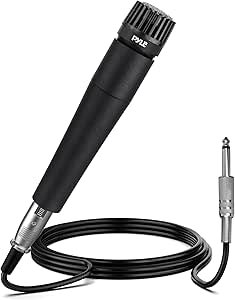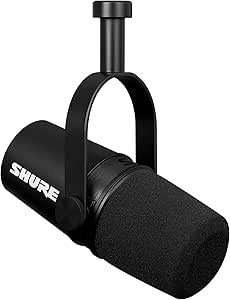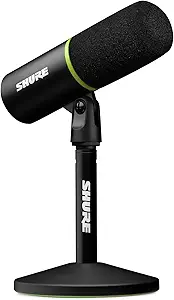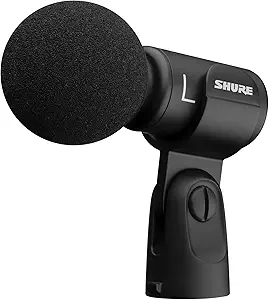PylePro Dynamic Handheld Microphone PDMIC78 review rugged design and exceptional sound clarity
PylePro Dynamic Handheld Microphone PDMIC78 review rugged design and exceptional sound clarity
- Remarkable durability ensures the microphone can withstand intense use, whether on stage or in the studio.
- The built-in pop filter effectively minimizes plosive sounds, delivering cleaner and more professional vocals.
- Produces clear and focused sound by isolating the voice from ambient noise, thanks to its unidirectional pickup pattern.
- High-quality audio output with impressive clarity and minimal distortion, making it suitable for both live performances and recordings.
- The 15-foot XLR cable provides ample length for flexible positioning during performances or setups.
As an Amazon Associate I earn from qualifying purchases.
Description
Initial Impressions of the PylePro PDMIC78
The PylePro PDMIC78 dynamic handheld microphone immediately catches the eye with its robust build and professional design. I’ve tested countless microphones over the years, and this one stands out due to its zinc alloy construction and steel mesh grill. It feels solid in the hand, and there’s a certain reassurance that it could take a knock or two without falling apart. Paired with the 15-foot XLR cable, it’s versatile enough for both studio and stage use, and I couldn’t wait to see how it would handle various scenarios.
Design and Build Quality
This microphone is clearly built to last. From the moment I unboxed it, I noticed its rugged zinc alloy body, which is not only durable but also gives it a premium feel. The steel mesh windscreen is another thoughtful addition, providing protection for the mic element while also working to reduce plosives. I’ve seen many microphones in this price range that feel flimsy, but this one is a clear exception. Its compact dimensions—1.24 inches by 6.14 inches—also make it very comfortable to hold during long performances or recording sessions.
What I particularly appreciated was the built-in acoustic pop filter, which minimizes those harsh “p” and “b” sounds without the need for an external filter. It’s a simple feature, but it makes a big difference, especially when capturing vocals.
Sound Quality and Performance
I was genuinely surprised by how well this mic handled vocals. The 50Hz-15KHz frequency response ensures a wide range of sound pickup, and the 600 Ohm impedance delivers a clean, undistorted signal. When testing it for vocals, the cardioid pickup pattern really shone. It effectively isolated my voice, cutting out any annoying background noise or feedback.
During a live jam session with a couple of friends, this microphone delivered exceptional sound clarity. The high gain before feedback meant I could push the volume without worrying about that dreaded screeching sound. It’s also quite forgiving when used with instruments—I gave it a go with my acoustic guitar, and the results were crisp and natural. While it’s marketed as a vocal microphone, its versatility is a big plus.
Key Benefits
- Durable build: Zinc alloy body and steel mesh grill stand up to wear and tear.
- Excellent sound clarity: Captures vocals and instruments with precision.
- Background noise reduction: Cardioid pattern ensures focused audio.
- Versatility: Suitable for live performances, studio use, and even karaoke.
Hurdles
Of course, no product is perfect, and the PylePro PDMIC78 does have a few areas where it could improve. While the 15-foot XLR cable is a fantastic addition, the build quality of the cable itself feels a bit cheap compared to the microphone. I noticed some stiffness and worry about its longevity with frequent use.
Additionally, the sensitivity rating of -54dB means it might not be the best choice for extremely quiet vocals or delicate recordings. You’ll need to pair it with a decent preamp to get the most out of it in such cases.
- Cable quality: The XLR cable could be more durable.
- Lower sensitivity: May require a preamp for quieter applications.
Product Competitors
In the crowded world of dynamic microphones, the PylePro PDMIC78 faces stiff competition. It’s often compared to the Shure SM58, which is a classic in this category. The Shure model is slightly more expensive but offers a more refined sound profile and better handling of extreme dynamics. However, the PylePro mic holds its own with its solid construction and affordability.
The Behringer XM8500 is another contender. It’s similarly priced and boasts a comparable cardioid pickup pattern. While the Behringer excels in noise rejection, it lacks the robust build quality of the PylePro. For someone who needs a durable mic for live performances, the PylePro is a better choice.
Financial Value
In terms of value for money, this microphone is hard to beat. It offers many features typically found on higher-end models, like the ultra-wide frequency response and rugged construction, at a fraction of the cost. If you’re on a budget but still want professional-grade performance, this is a fantastic option.
I’ve spent more on microphones in the past that didn’t deliver nearly as much. While it may not replace high-end studio mics for critical recordings, it’s more than adequate for live performances, podcasts, and casual recording sessions. It’s worth every penny if durability and functionality are your main priorities.
Versatility and Applications
What impressed me most about this microphone is its versatility. I’ve used it during live performances, recording vocals in the studio, and even for some casual karaoke sessions with friends. Its low noise circuitry ensures clean recordings, and the uni-directional cardioid pattern helps keep the focus on the sound source, even in noisy environments.
I also tested it on a gaming console for some live streaming, and it performed surprisingly well. While it might not be the first choice for gamers, it’s definitely a viable option for those who want a reliable, all-purpose microphone.
This mic could easily be a go-to for musicians, podcasters, and even public speakers looking for a reliable, affordable option.
Testing the PylePro PDMIC78 has been a rewarding experience overall. While it has a few limitations, its strengths—durability, sound clarity, and affordability—make it a standout choice in its category. Whether you’re a budding musician, a podcaster on a budget, or just someone who needs a dependable microphone, this one ticks a lot of boxes.
Additional information
| Item Weight | 1.3 pounds |
|---|---|
| Impedance | 600 Ohm |
| Maximum Frequency | 15000 Hz |
| Microphone Form Factor | Handheld |
| Minimum Frequency | 50 Hz |
| Item dimensions L x W x H | 3.5 x 10 x 5 inches |
| Power Source | Corded Electric |
| Material | Zinc Alloy Metal |
| SignaltoNoise Ratio | 70 dB |
| Hardware Platform | Gaming Console, PC, Karaoke Machine |
| Number of Channels | 1 |
| Frequency Range | 0.05 khz – 15 khz |
| Frequency Response | 15 KHz |
| Global Trade Identification Number | 00611101539995, 00068889007039 |
| Manufacturer | Sound Around |
| UPC | 611101539995 688890070398 823019877919 068889007039 702248798861 012304051107 809198925771 |
| Product Dimensions | 3.5 x 10 x 5 inches |
| Item model number | PDMIC78 |
| Is Discontinued By Manufacturer | No |
| Country of Origin | China |













